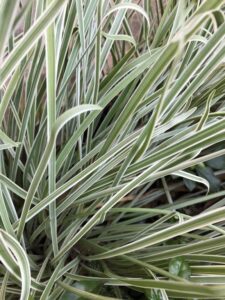
Garlic in society
By Clive Larkman
Since the Columbian Exchange, a few everyday flavours have become a key ingredient in most diets, one of which is garlic. Common garlic is Allium sativum, one of the oldest cultivated plants. There are reports of it being grown around 5000 years BC. It has become a major ingredient in the food of nearly all cultures. It has also developed a myriad of health benefits and numerous anecdotes and myths about its powers.
The plant is a monocot in the genus Allium, which includes onions, leeks, and chives. It is in the family Allioideae, although there is still some debate on this. Some now say it is a sub-family, along with the Agapanthoideae (Agapanthus) and Amaryllidoideae (amaryllis, daffodils, snowdrops) in the large family Amaryllidaceae. This also includes the popular garden plant Tulbaghia or Society Garlic.
All these plants are very similar in appearance, and most are edible. The Tulbaghia group comprises two genera, Tulbaghia and Prototulbaghia, both native to Southern Africa. This whole group is under constant review, and Prototulbaghia is now considered a synonym. There are around 30 species of Tulbaghia, and a small range of them are possibly Tulbaghia or possibly Agapanthus. They are all referred to as Society Garlic because Dutch settlers to South Africa thought it was a more polite spice to use for flavouring dishes than true garlic, particularly for social events. Unlike traditional garlic, the sulphur in the foliage doesn’t build up in the human blood system, giving off the classic ‘garlic breath’. Hence, it was felt that you could eat it without the telltale ‘garlic breath’ and were able to go out in society.

Several species are grown in Australia, and the most common is Tulbaghia violaceae, called Society Garlic. Other species grown here include Tulbaghia cominsii (Dwarf Society Garlic), Tulbaghia maritima (Coastal Society Garlic)and Tulbaghia simmleri (Sweet Society Garlic). They all have a very similar appearance with long, narrow, soft green foliage and a strong garlic scent from the crushed foliage. The flowers form an umbrella-like head on small stems. The stems come from a central point on top of a long thin stem.
Across the genus, the flowers occur over the summer months and range from white to pale mauve. They have a peppery flavour and make good edible flowers. They have a sweet fragrance which occurs at night for most species, as moths pollinate them. s the name implies, Tulbaghia violaceae has violet, mauve flowers, which are most fragrant during the daytime due to this species being pollinated by butterflies.
Society Garlic is a fast-growing, bulbous plant that grows to around 60cm tall and 40cm wide. The foliage is a typical monocot, strap-like and slightly fleshy, and strongly smells of garlic. They grow from fat, tuberous roots, which spread to form clumps of plants. These are edible and have been used for various forms of natural medicine.
The plants are quite hardy to drought in most soils and will grow in full sun or partial shade. They prefer open, well-drained but moist soil. The ability to grow across this range of conditions makes them excellent garden plants. They are especially well suited as border plants to large perennial beds or alongside grass pathways.
The plants are classic ‘edimentals’, popular for all types of small and large landscape gardens and quite useful in the garden kitchen. Leaves and flowers can be used raw or cooked. The fleshy roots and the bulbs are reportedly edible. Medicinally, the crushed leaves have been used to treat sinus headaches, and roots and fresh bulbs are boiled in water. They are reportedly used for a range of natural medicines.
Overall, Society Garlic, including all the species and cultivars are great although under-used garden plants. They have a tropical appearance and do quite well in both the sub and full tropics. They are the perfect plant for all gardens and small and commercial landscapes across Australia.
